A course in heritage interpretation
It was supposed to be just a course, but what emerged were fascinating stories about Hajnówka and its inhabitants. In an interview with one of the participants, you can find out what the hill in the city park symbolises and how to tell the story without covering up what is most important. Agnieszka Krok, a Polish language teacher by profession, is the author of one of the most surprising interpretive walks in Hajnówka.
You took part in a heritage interpretation course. Initially, it was supposed to be just a course. However, the added value of this project was that willing participants could prepare an interpretive walk, i.e. a specific outcome of the course. You took up this challenge.
Agnieszka Krok: Yes, because when I start something, I finish it…
A good feature.
However, it was not easy. During the course I had doubts about whether to continue, whether it was definitely for me. I felt that the content of the training was aimed at guides rather than teachers, and I was spending a lot of my free time on it.
I hear you're not the only one....
Yes. However, at one point the guide showed us a photograph that spoke to me: there was a fire burning in the fireplace, which was completely covered by the guides warming themselves by it. You could only see their backs. Ms Magda (Guide Magdalena Kuś from the Dyer Workshop – editor’s note) then said: “The guide thus covers up what is most important. Just as they covered up that fire, the subject of our walk is often covered up when there is too much information in it and not one thing to link it together”. And that got me thinking….
A beautiful metaphor...
I realised that we teachers often cover up what is most important with our person, lecture, amount of information, details or imposing our opinion. This changed my approach to this course. I found that this method could be useful to me in my work. I wanted to gain new skills, to improve my teaching skills.

Interpretive walk. On the left, Agnieszka Krok
But I heard that your walk went spectacularly....
I don’t know if spectacular…
People were delighted...
They were certainly moved. They didn’t expect what I was getting at, what the punch line of the walk would be. A good way to keep the audience’s attention is to surprise them and here it was. There was an element of surprise in every object I used in my interpretive walk and that’s probably why they enjoyed it so much.
All right, then, please let us in on the secret.
I wouldn’t want to say exactly what it consists of. There might be a reader on the other side one day, so I wouldn’t want to spoil the reception and the surprise.
Do you mean to say that one day there will come a time when you will organise this walk for someone as a guide?
I can organise on special request (laughs).
The subject I took up was the “Terebenthen” factory – the United Turpentine Factory of the Białowieża Forest , which used to be located on the site of today’s city park. It occupied a very large area. I noticed that many residents are not aware of it.
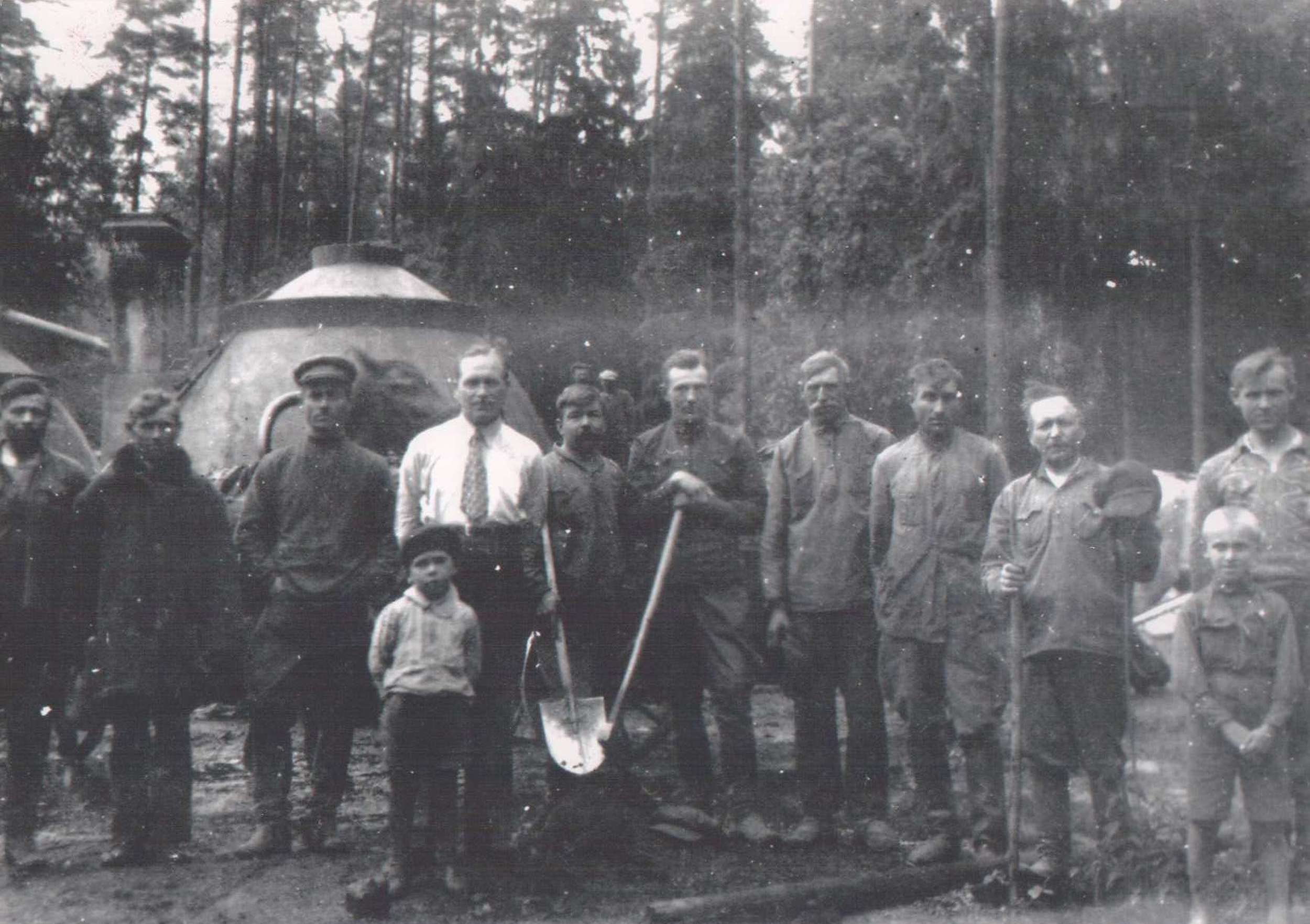
Workers at the tar works. A copula is visible in the background. Photo from the collection of the Dr. Tadeusz Rakowiecki Municipal Public Library in Hajnówka
At the moment there is nothing left there....
That’s right, and it’s great that a city park has been created on the site. My aim was to find the crumbs that remained of the factory mentioned above. I tried to answer the question: are we able to find elements consistent with this factory and the people of that time that still exist in the park space? It turned out that yes. We just need to look at them in the right way. I just helped to find them.
It’s good that the park was created in a place that used to poison the whole neighbourhood. It’s also a symbol of this city.
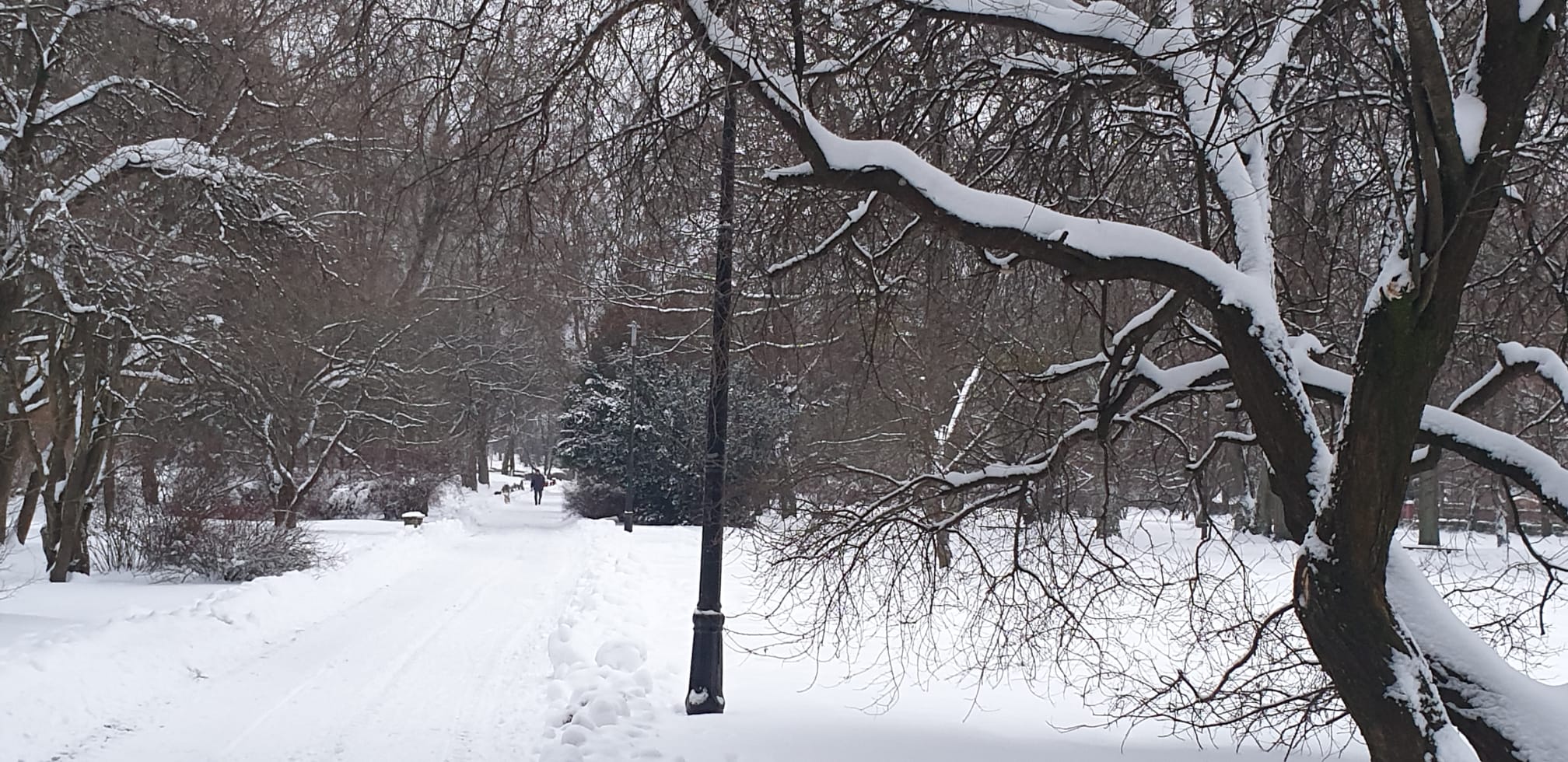
The city park. Photo: Anna Pacewicz
Did you check how many inhabitants of Hajnówka worked in the turpentine factory at that time?
Yes, in a source I found information that the population of the town in 1929 was 748, and ten years later it was already 17,000. Which means a very rapid growth. In 1930 there were almost 2,000 people employed in the factories. These were immigrant workers from faraway places. They worked in the surrounding Wood Factories, the Turpentine Factory, the Chemical Factory and the Forest Railway Company. At the Turpentine Works, the woodpine was burned with little air, on the basis of vaporisation. Among other things, turpentine was produced in this way.
By the way, is it now possible to get turpentine somewhere?
You can, apparently it is not the same though. For my walk I was looking for the most natural one that had the right smell, as you can also buy unscented.
What is the smell similar to?
To solvent. Although there is a slight pine smell piercing through. Imagine that the workers inhaled the fumes throughout the day at the plant, and also smelled them after work, as the smell spread throughout the town.
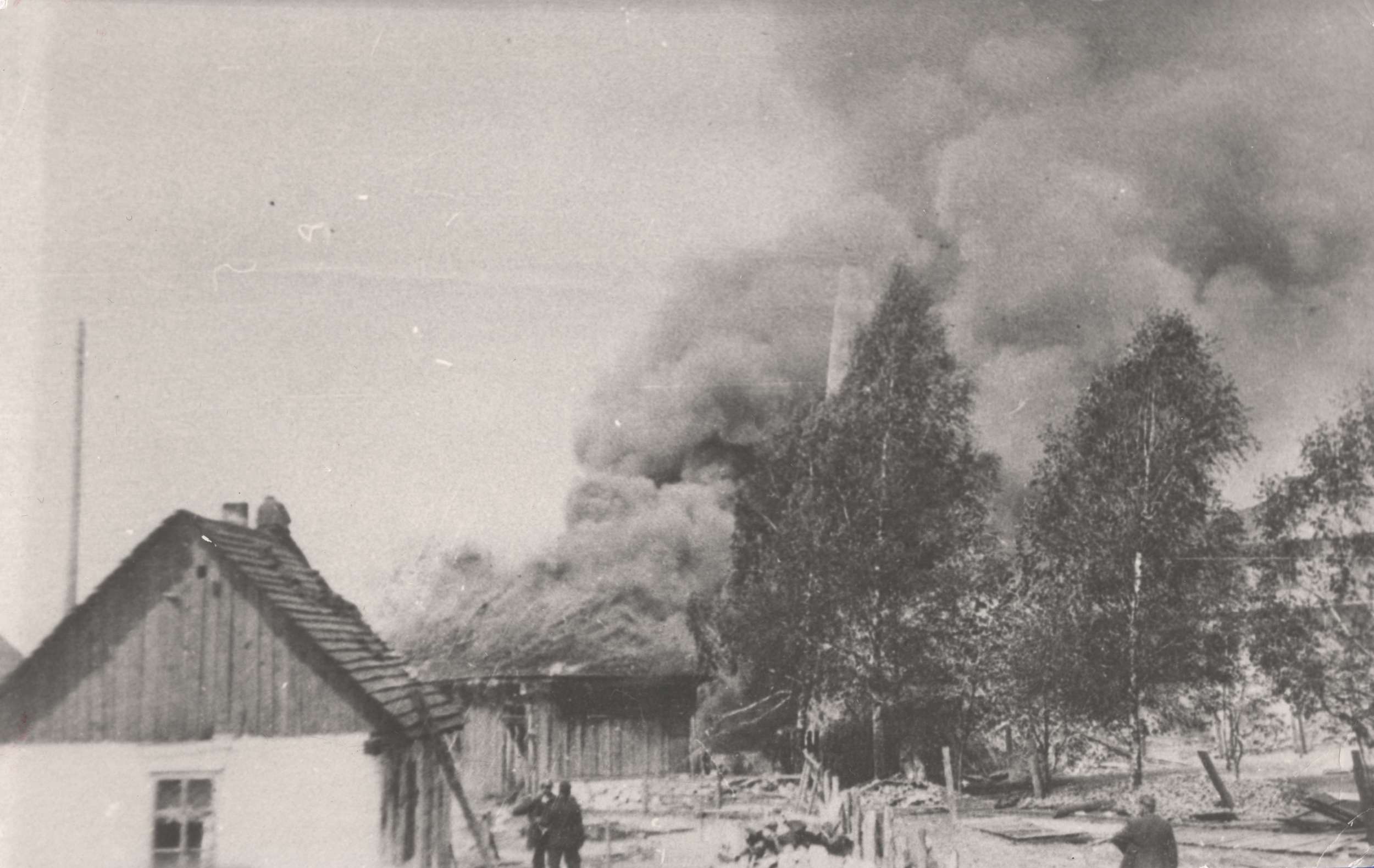
Fire at the turpentine factory in May 1935. After the fire, there was a lot of ash on the streets. Photo from the collection of the Dr. Tadeusz Rakowiecki Municipal Public Library in Hajnówka
Will you give at least one example of this crumb that you have found?
Such a simplest one, which should have been known to all Hajnówka residents, is certainly the monument to the “Unbroken” by Józef Marek, i.e. wooden, tall figures of figures standing on a hill. This art installation is dedicated to the forestry workers of the inter-war period – it was my ‘starting point’. The other three are sculptures and other elements of the park – with each of these places I referred to the people who worked there, not to the plant itself. I wouldn’t want anyone to think that I consider myself an expert on the former turpentine works. That is not the case. It’s only recently that I’ve become aware of this moment in the city’s history, which has only helped me to understand what the situation was for the people who settled Hajnówka.
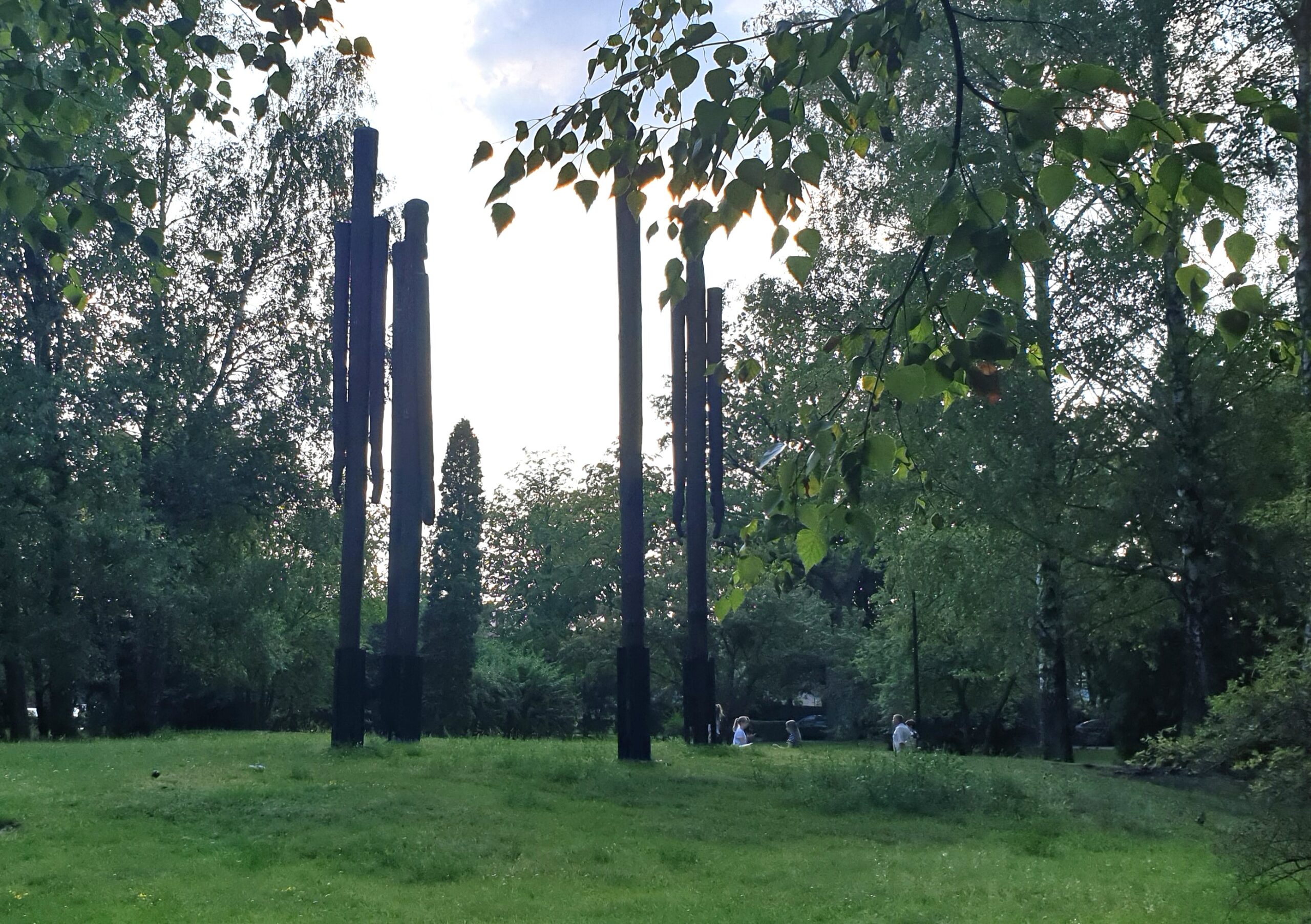
Fot. Anna Pacewicz
And what was the element of surprise? I'm going to drag your tongue because you made me very interested in it.
I’m afraid I’m going to say everything (laughs).
How about at least a hill?
Agreed. A hill in the city park, which is where the Turpentine Factory once stood. Tell me, why do you climb the hill?
To observe the world from a better perspective.
Just for that? And in winter?
To go sledding down it.
And who uses it then?
Children.
How many?
Probably a lot. If it's snowing, whole crowds.
What do they do when there are so many of them?
They go crazy, play, fall over, shout. All the things they like to do.
Do you know that they are often children who come from the surrounding villages? They only get to know each other on the hill. Is there chaos and constant arguing, or is there an adult among them who keeps order?
No, it happens spontaneously.
Exactly. That is, in spite of the age difference, networking problems and shyness, children are able to communicate with each other. Especially when they really want to.
The hill is such a symbol of communication, of learning to be a community, of making contact. In the same way that children today communicate on a sledge hill, a hundred years ago, in this same place, the employees of the turpentine factory and other factories were able to communicate to strike against poor working conditions.
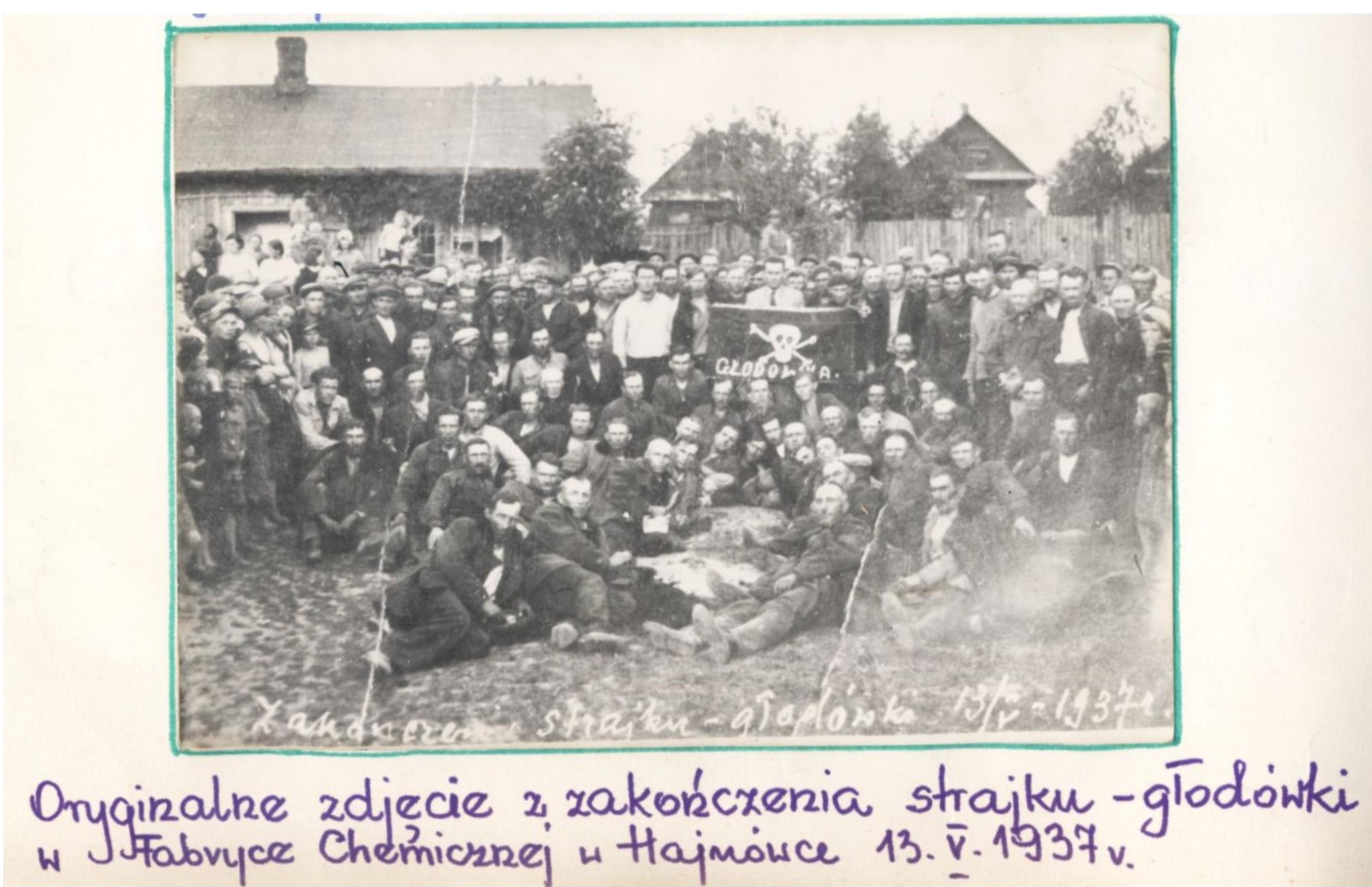
Photograph published in a publication to mark the 70th anniversary of the granting of Hajnówka’s city rights. A scan of the photo comes from the chronicle of the Primary School No. 2 in Hajnówka
Beautiful...
You have now taken part in a piece of interpretive dialogue, as you answered my questions that led us to this piece of Hajnówka history.
Thank you for this exclusive interview (laughs). If we were to explain what interpretive dialogue is all about....
It’s difficult to say in a few words. Maybe I’ll outline what this method is for me. It is a story that is based on universal values, it relates to our experiences and emotions, to contemporary realities, to what is important to us. Even though we have better working conditions, we are warm, we have food to eat, we have a family, a home, we have a decent life, people in Hajnówka have not always had it this way. My interpretive walk is not meant to accuse someone with numbers and facts, but to help you feel for the people who did not have what we have now. This is regarding the turpentine plant, but there are many universal values and they can be referred to in many other subjects. Only then are we able to remember something if it moves us in some way. And universal values apply to everyone.
I believe that in our Hajnówka park we do not need boards or monuments to tell us that something happened here, the memory of these people, which should be in us, the residents, is enough. Let us remember that Hajnówka was largely created by people who came from all over Poland, that probably many of us have an ancestor who came from the depths of the country to work in the timber mills. I found such a person among my distant relatives who came here from Mazowsze in the 1930s to source carpina. At one time there were six different nationalities living here. In the inter-war years, at a time of great poverty throughout Poland, people were united by one goal – they wanted to make a decent living. For this, they came to distant Hajnówka, which they knew nothing about. Away from their families, with no way of communicating with their loved ones. These people showed great courage and determination and they are, in my opinion, the heroes of this town.
This is a completely different perspective on the history of Hajnówka. After all, the workers you mention are not so-called monumental figures, they are not uprising leaders, scientists or doctors, they are ordinary people. They are workers. And it was they who made this city.
Yes, they were the strength of Hajnówka then, and we should remember them.
Perhaps this question should have been asked at the beginning, but I will ask it now. What actually made you take this course?
Initially, the need to develop myself – my pedagogical skills – so that in my lessons I reinforce the ability to pay attention to what is most important. And preferably in a way that the students find it on their own. We can use the method of interpretive dialogue at school, especially in Polish language lessons. An additional aspect was the desire to broaden my knowledge of the city in order to then introduce my pupils to it. I have to admit that at first I was slightly disappointed that this was not the case….

That there will be no dates or events...
… just something completely different. I thought this was aimed at the guides, most of the participants had a very rich knowledge of the city or the natural world, yet I am not from Hajnówka and barely recognise the most important tree species. What am I doing here? – I wondered. Over time, however, this course led me to self-realisation. I wanted to discover something myself and learn this method. I’m glad that this has led me to some sources and to learn more about our city.
Preparing an interpretive walk is not only about analysing sources, but also a lot of your own work and creativity.
I really like working with metaphor. In fact, every object that was included in my interpretive walk was based on a metaphor. At a certain point I felt I knew how to find my way around it.
Indeed, the story of the hill is actually a textbook example of metaphor.
Especially now that the hill is covered in snow, I advise you to go to this place. When you look at the children playing, shouting and arguing with each other, you will be reminded of the story of the workers who, despite their differences, were able to unite and communicate to stand together to fight a hundred years ago.
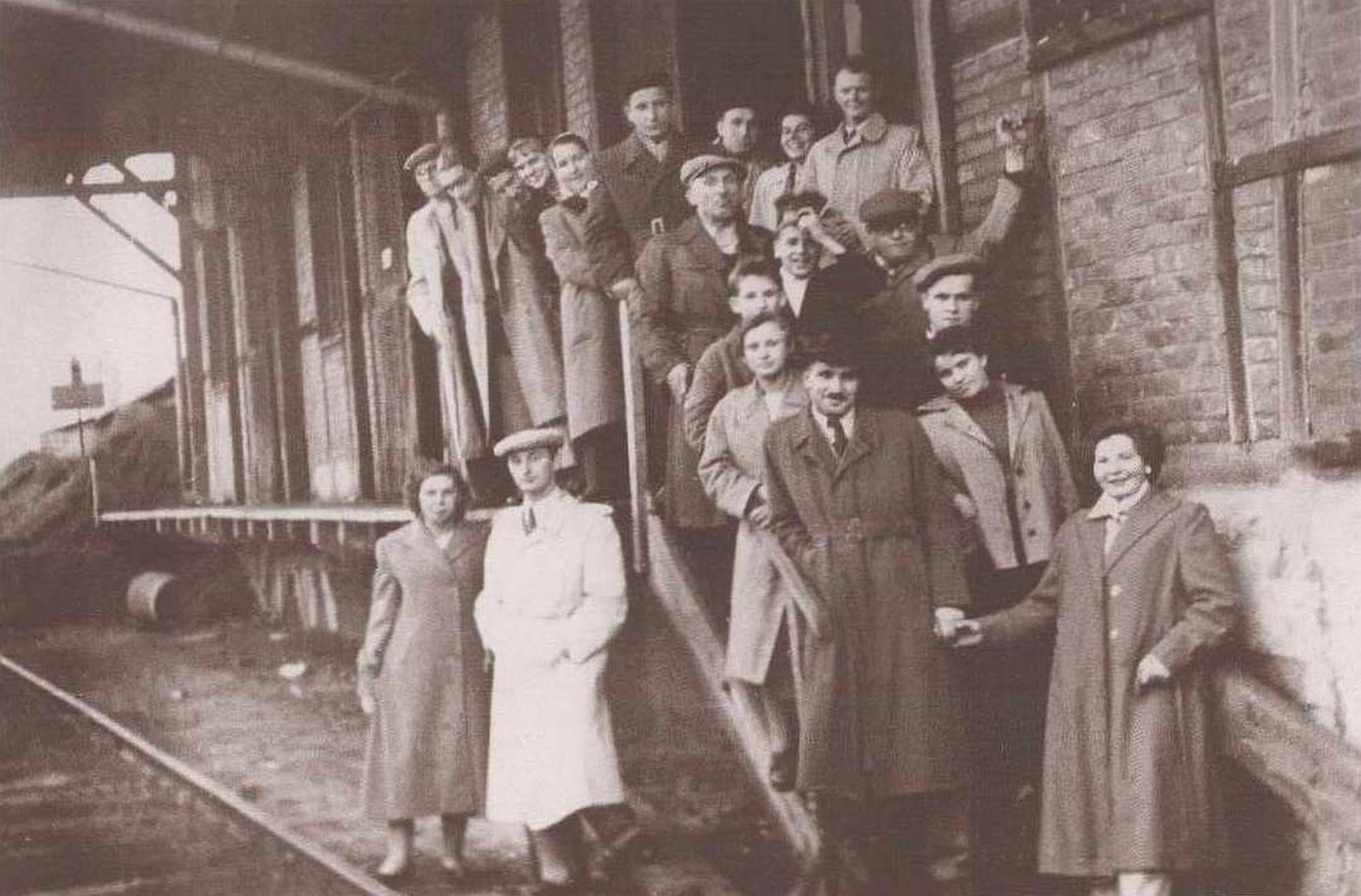
Ramp of the turpentine factory (in the area of today’s Parkowa and Białowieska Streets), 1938. Photo from the collection of the Dr. Tadeusz Rakowiecki Municipal Public Library in Hajnówka
And this ability to communicate is still very much needed in Hajnówka.
Of course it is.
The Heritage Interpretation Course is organised by the Foundation for Development and Educational Initiatives. It is part of the project ‘Guardians of memory – the art of heritage interpretation’. The course took place in the first half of October.
